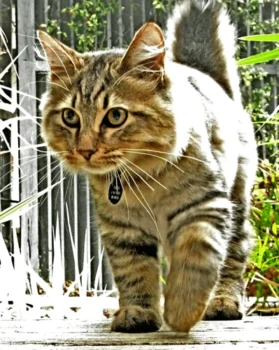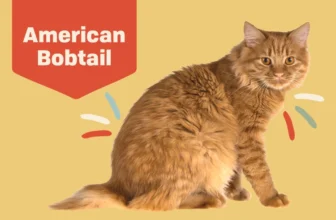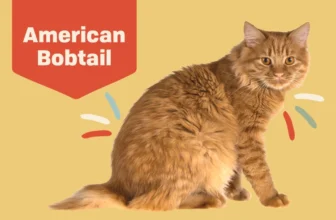Have you ever wondered how the facial features of American Bobtails are determined? While we may think it’s simply a matter of genetics, the complexity of feline genetics can leave us feeling perplexed. However, understanding the role of genetics in determining an American Bobtail’s facial features is crucial for breeders and cat lovers alike. In this article, we will explore the unique characteristics of American Bobtails, the science of cat genetics, and the influence of breeders on these felines’ facial features. With a better understanding of the genetics behind the American Bobtail’s appearance, we can appreciate these cats even more.
The Role of Genetics in American Bobtail Facial Features

Understanding the genetic makeup of American Bobtails is essential in comprehending their unique physical attributes, especially their facial features. The American Bobtail is a remarkable breed of cat with distinctive physical characteristics that differentiate it from other felines. As a result, cat lovers who are interested in owning an American Bobtail would want to know what determines their adorable facial features. In this section, we will delve into the science of genetics and see how it affects the facial features of American Bobtails. Understanding the genetics behind these cute cats will provide owners with insight into the different variations in their appearance. Let’s explore the role of genetics in determining American Bobtail facial features. To learn more about identifying American Bobtail facial features, click here.
What are American Bobtails?
American Bobtails are beautiful cats known for their distinct facial features, among other characteristics. These felines, which were first bred in the United States in the 1960s, are beloved pets for many Americans.
Physical Description
The American Bobtail is a medium to large-sized cat that weighs between 7 to 16 pounds. They have a muscular build with broad shoulders, giving them a powerful appearance. They have a short, stubby tail that is commonly referred to as a “bobtail.”
Coat
American Bobtails have a shaggy, medium-length coat that can come in a variety of colors and patterns. They have tufted ears and large, expressive eyes that add to their endearing appearance.
Personality
Not only are American Bobtails known for their unique physical features, but they are also known for their friendly and social personalities. They are intelligent, playful, and affectionate cats that make great family pets.
If you are interested in learning more about American Bobtail facial features, click here.
Understanding Cat Genetics
Understanding the genetics of American Bobtails is crucial in determining their unique facial features. These cats possess a dominant gene that contributes to their bobbed tails and can also affect other physical characteristics. However, feline genetics can be complex and involve various genes and their interactions.
One essential concept in genetics is the idea of alleles, which are different versions of a gene. For example, a gene that controls coat color may have an allele for black coat and an allele for white coat. A cat inherits one allele from each parent, which determines their physical traits.
In the case of American Bobtails, the gene responsible for their characteristic short tails is dominant, meaning that even if only one parent carries the gene, the offspring will likely display the trait. However, the expression of the gene can be influenced by other genes, leading to variations in the length of the tail and other physical features.
Understanding the inheritance patterns of genes is crucial in predicting the traits of an American Bobtail offspring. For example, certain traits may be controlled by a single gene, while others may be polygenic, meaning that multiple genes contribute to the trait. Breeders can use this knowledge to select for desirable traits and improve the overall quality of the breed.
Table: Basic Genetic Terms
| Term | Definition |
|---|---|
| Gene | A segment of DNA that codes for a specific trait. |
| Allele | A version of a gene that determines a specific trait. |
| Dominant | A type of allele that is expressed even if only one copy is present. |
| Recessive | A type of allele that is only expressed if two copies are present. |
| Polygenic | A trait that is controlled by multiple genes. |
Having a basic understanding of feline genetics can help breeders make informed decisions when selecting cats for breeding, as well as predicting the traits of their offspring. By working to maintain desirable physical and behavioral traits, breeders can continue to improve the overall quality of the American Bobtail breed.
Learn more about the facial features and personality of American Bobtails here.
Facial Features of American Bobtails

As we examine the facial features of American Bobtails, we begin to unravel some of the mysteries behind their adorable and unique appearances. From their expressive eyes to their distinctive mustaches, there is no mistaking an American Bobtail. Let’s explore some of the fascinating characteristics that make these cats stand out in the feline world. If you want to learn more about the evolution of American Bobtail’s facial features, check out our article on the subject.
Unique Characteristics
American Bobtails are known for their distinctive facial features which are determined by their genetics. They have a strong, broad face with high cheekbones, a short snout, and a powerful jaw, giving them an overall sturdy and muscular look. But what makes American Bobtails truly unique is their wild appearance, with tufted ears and bold facial markings in different patterns and colors.
Their ears are short, rounded, and tufted, which is a trait believed to have been inherited from their wildcat ancestor. The tufts are usually around an inch long, and they grow outward and upward from the upper part of the ear, resembling the Lynx.
Their eyes are large and expressive, with varying colors ranging from amber to green or blue. It’s said that some American Bobtails can have heterochromia, meaning that both eyes are different colors, which only adds to their unique look.
Their facial markings are highly variable, ranging from spots, stripes, and patterns that can come in different colors such as black, brown, blue, or red. One of the most common patterns is the tabby pattern, which creates swirling stripes or lines that give the cat a wild appearance.
Finally, the muzzle of the American Bobtail is short and powerful, with a prominent, broad nose and strong jaws. Combined with their striking eyes and tufted ears, this creates quite a commanding presence.
All these features make the American Bobtail a very unique and recognizable breed. If you want to learn more about their grooming needs, check out our article on American Bobtail grooming tips. Or, if you want to understand better the facial expressions of American Bobtails, we invite you to read our article on American Bobtail Facial Expressions.
Variations in Appearance
When it comes to American Bobtail cats, there is a wide range of variations in their appearance. Some of these variations are due to genetics, while others are due to environmental and lifestyle factors. Here are some of the variations you might see in an American Bobtail’s appearance:
- Fur length: American Bobtails can have either short or long fur. The length of their fur can affect their appearance, as well as their grooming needs.
- Fur color: These cats can come in a variety of colors and patterns, including tabby, solid, and tortoiseshell. The color of their fur is determined by genetics, and certain patterns are more common in certain breeds.
- Eye color: American Bobtails can have blue, green, yellow, or brown eyes. Eye color is also genetically determined, and can vary within a litter of kittens.
- Ear shape: This breed is known for its distinctive ears, which are usually tufted and can be either straight or slightly curled. However, not all American Bobtails have the same ear shape, and some may have non-tufted or more rounded ears.
- Facial structure: While American Bobtails are known for their distinctive facial features, such as their broad nose and strong jaw, there can still be some variation from cat to cat. Some may have a more angular face, while others may have a more rounded face.
It’s important to note that while genetics play a significant role in determining an American Bobtail’s appearance, factors such as diet, exercise, and grooming can also have an impact. For example, a cat with a healthy diet and plenty of exercise may have a shinier coat and brighter eyes than a cat that doesn’t receive the same level of care. Additionally, regular grooming can help to keep a cat’s coat looking healthy and prevent matting or tangles.
How Breeders Can Influence Facial Features
When it comes to breeding American Bobtails, breeders play a significant role in shaping the appearance of the breed. Through careful selective breeding and genetic manipulation, breeders can have a significant influence on the facial features of American Bobtails. But how exactly do breeders go about influencing the facial features of these beloved cats? Let’s delve into the science behind breeding and how breeders can shape a cat’s appearance.
The Science of Breeding
Breeding American Bobtails with distinct facial features is both an art and science. It requires careful selection of breeding pairs and understanding of the genetics involved. One of the key principles is that genes control the traits that are passed from one generation to the next. Strong breeding programs focus on selecting cats with dominant genes. These are genes that are more likely to be passed on to future offspring.
Line Breeding: One technique used by breeders is line breeding. This involves breeding cats that are close relatives, such as parent and offspring, or siblings. The goal of line breeding is to maintain consistency in specific traits over several generations. However, it is important to avoid inbreeding, as this can lead to genetic health issues.
Outcrossing: Another technique is outcrossing. This involves breeding American Bobtails with cats from other breeds. Outcrossing is used when breeders want to introduce new traits or increase genetic diversity. However, it is essential to select cats that are compatible with the American Bobtail breed and to avoid introducing genetic defects.
Genetic Testing: Breeders also rely on genetic testing to identify cats with desirable traits. This involves analyzing the cat’s DNA to understand its genetic makeup. Genetic testing can identify genes responsible for specific traits, such as fur color and texture, and can help breeders choose cats with the desired facial features.
Continuous Evaluation: Finally, breeders must continuously evaluate their breeding program to ensure that they are breeding cats with the desired facial features. Evaluation involves monitoring the progress of each cat’s traits over several generations to make adjustments to the breeding program.
Breeding American Bobtails with specific facial features is a complex process that requires understanding the principles of genetics, careful selection of breeding pairs, genetic testing, and continuous evaluation of breeding programs. By using these techniques, breeders can advance the American Bobtail breed and improve the appearance of their cats.
The Future of American Bobtail Genetics
As with any breed, the future of American Bobtail genetics is constantly evolving. While breeders are dedicated to preserving the unique traits of American Bobtails, they must also adapt to new scientific discoveries and advancements in genetics research. Here are some of the ways that American Bobtail genetics could potentially evolve in the future:
- Increased Knowledge of Genetics: As more research is conducted on feline genetics, breeders will have a greater understanding of how certain traits are inherited and expressed in American Bobtails. This could lead to more precise breeding programs that produce cats with even more distinct facial features.
- New Traits: Breeders may continue to introduce new traits into the American Bobtail gene pool. For example, they may breed for cats with larger or smaller facial structures, or experiment with different combinations of color and pattern.
- Health Considerations: As with any breed, health is always a concern. Breeders may focus on developing American Bobtails with healthier facial structures, as well as finding ways to reduce the prevalence of genetic disorders that affect the breed.
- Popularity: As the American Bobtail grows in popularity, there may be increased demand for certain facial features or traits. This could result in breeders focusing more heavily on those characteristics in their breeding programs.
The future of American Bobtail genetics is uncertain, but one thing is for sure – breeders will always be working to produce cats with unique and distinct facial features. As the role of genetics in determining these features becomes more fully understood, we can expect to see even more exciting changes in the American Bobtail breed.
Conclusion
After examining the role of genetics in determining an American Bobtail’s facial features, we can conclude that genetics plays a significant role in shaping their appearance. Through understanding cat genetics, breeders are able to selectively breed for desired facial features.
However, it’s important to note that there is still variation in appearance even within American Bobtail litters. This can be influenced by random genetic variation and environmental factors.
Breeders have the potential to influence the appearance of American Bobtails through selective breeding, but it’s important to prioritize the health and well-being of the cats as well. The science of breeding should always be conducted with ethical and responsible practices.
As advancements in genetics research continue, the future of American Bobtail genetics holds promise for potential developments in breed appearance and health. Overall, genetics plays a fascinating and important role in shaping the appearance of American Bobtails and other cat breeds.
Frequently Asked Questions
What health issues are commonly seen in American Bobtails?
While American Bobtails are generally healthy cats, they are prone to certain health issues such as hip dysplasia, urinary tract infections, and hypertrophic cardiomyopathy.
Are American Bobtails hypoallergenic?
While no cat breed is completely hypoallergenic, some people with allergies find that they are less allergic to American Bobtails due to their short, low-shedding coats.
What is the life expectancy of an American Bobtail?
On average, American Bobtails live to be around 13-15 years old.
Can American Bobtails be kept as indoor-only cats?
Absolutely! In fact, it’s recommended that American Bobtails be kept as indoor-only cats to prevent them from coming into contact with potential predators or getting hit by cars.
How often should I groom my American Bobtail?
Because their coat is short and low-maintenance, you only need to groom your American Bobtail once a week with a bristle brush to remove loose fur and distribute skin oils.
Do American Bobtails get along well with other cats and pets?
American Bobtails generally get along well with other cats and even dogs, as long as they are properly socialized from a young age.
What is the temperament of an American Bobtail?
American Bobtails are known for their friendly and affectionate nature. They are intelligent, playful, and make great companions for both individuals and families.
What kind of diet is best for an American Bobtail?
It is important to feed your American Bobtail a high-quality diet that is protein-rich and low in fillers such as corn or wheat. Wet food can also be beneficial for maintaining their urinary tract health.
At what age are American Bobtails fully grown?
Most American Bobtails reach their full size and weight by the age of 2-3 years old.
Are American Bobtails a relatively new breed?
Yes, American Bobtails were first developed in the 1960s in the United States. They are considered to be a fairly new and rare breed.







